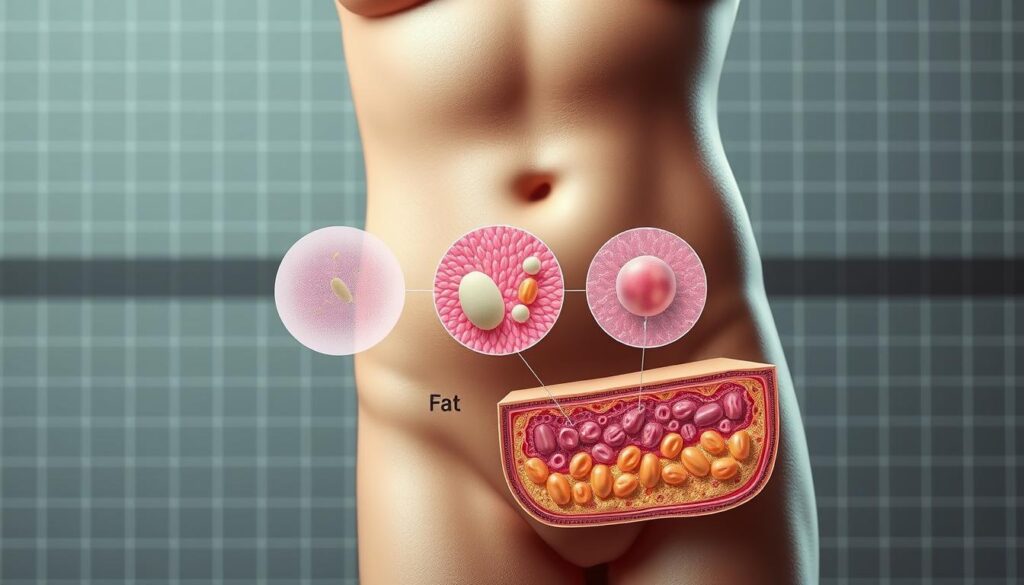The Science Behind Belly Fat: Causes and Solutions
Are you struggling with stubborn belly fat? You’re not alone. Excess fat around the abdominal area is not just a cosmetic issue; it’s a health concern. Belly fat accumulation is linked to various health problems, including diabetes, heart disease, and certain cancers.
Understanding the causes of belly fat is crucial to finding effective solutions. Factors such as poor diet, lack of exercise, stress, and genetics can contribute to fat accumulation around the belly. Fortunately, there are natural ways to detox your body and reduce belly fat. By incorporating natural detoxification methods into your lifestyle, you can improve your overall health and reduce the risk of chronic diseases.
Key Takeaways
- Belly fat is linked to various serious health issues.
- Poor diet, lack of exercise, and stress contribute to belly fat.
- Natural detoxification can help reduce belly fat.
- Lifestyle changes can improve overall health.
- Reducing belly fat lowers the risk of chronic diseases.
Understanding Belly Fat: More Than Just Aesthetics
While many view belly fat as merely an aesthetic problem, it poses serious health risks that shouldn’t be ignored. Belly fat, or abdominal obesity, is a complex issue that affects not just your appearance but your overall health and wellbeing.
Different Types of Belly Fat
Belly fat is not just one type; it’s categorized mainly into two types: subcutaneous and visceral fat.
Subcutaneous Fat: The Fat You Can Pinch
Subcutaneous fat is the layer of fat just beneath the skin. It’s the fat you can pinch around your abdomen. While it can be unsightly, it’s generally considered less harmful than visceral fat.
Visceral Fat: The Hidden Danger
Visceral fat, on the other hand, is located deeper in the abdominal cavity. It surrounds your internal organs, such as the liver, stomach, and intestines. Visceral fat is metabolically active, releasing substances that can lead to inflammation and increase the risk of various health problems. Incorporating a detox diet plan at home can help reduce visceral fat by promoting the consumption of anti-inflammatory foods.
Why Belly Fat Is Particularly Concerning for Your Health
Belly fat, especially visceral fat, is linked to a higher risk of several serious health conditions. These include cardiovascular disease, type 2 diabetes, and certain types of cancer. The presence of excess belly fat can also lead to metabolic syndrome, a cluster of conditions that occur together, increasing your risk of heart disease, stroke, and diabetes. Practicing body detoxification at home through healthy dietary choices and regular exercise can be a step towards mitigating these risks.
Understanding the risks associated with belly fat is the first step towards addressing it. By adopting a healthier lifestyle, including dietary changes and regular physical activity, you can reduce your belly fat and improve your overall health. Simple home remedies to detox your body, such as drinking plenty of water and consuming fiber-rich foods, can also support your journey towards a healthier you.
The Science Behind Belly Fat: Causes and Solutions
To combat belly fat, you need to understand the science behind fat storage and metabolism. Your body stores fat in various ways, and understanding these processes can help you address the issue more effectively.
How Your Body Stores and Processes Fat
Fat storage in your body is a complex process involving fat cells, or adipocytes. These cells are designed to store energy in the form of fat.
The Biology of Fat Cells
Fat cells are not just passive storage units; they actively participate in energy metabolism and hormone regulation. When you consume more calories than you burn, the excess energy is stored in these cells, leading to fat accumulation.
The Fat Storage Process
The process begins with the digestion of food, particularly fats and carbohydrates, which are then absorbed into the bloodstream. Insulin, a hormone produced by the pancreas, facilitates the uptake of glucose by cells, and any excess glucose is converted into fat and stored in adipocytes.
Why Your Abdomen Is a Prime Fat Storage Area
The abdomen is a preferred site for fat storage due to both evolutionary and modern lifestyle factors.
Evolutionary Perspectives
Historically, storing fat around the abdomen was advantageous for survival during periods of famine or when food was scarce. This visceral fat is metabolically active and can be mobilized quickly when energy is needed.
Modern Lifestyle Implications
In today’s sedentary lifestyle, this evolutionary advantage turns into a disadvantage. Lack of physical activity, coupled with a diet high in processed foods and sugars, leads to excessive fat accumulation around the abdomen.
| Factors Influencing Belly Fat | Description | Impact |
|---|---|---|
| Genetics | Inherited traits affecting fat distribution | Predisposition to store fat abdominally |
| Diet | High intake of processed foods and sugars | Increased fat storage around the abdomen |
| Physical Activity | Sedentary lifestyle | Reduced fat burning, increased abdominal fat |

Understanding these factors can help you make informed decisions about your lifestyle and diet to reduce belly fat. By adopting holistic detoxification techniques and natural ways to cleanse your body, you can improve your overall health and reduce fat accumulation.
Hormonal Influences on Belly Fat Accumulation
Understanding the hormonal influences on belly fat can be crucial for effective weight management. Hormones play a vital role in regulating various bodily functions, including fat distribution. When hormonal balances are disrupted, it can lead to increased fat storage around the abdominal area.
Cortisol: How Your Stress Hormone Promotes Belly Fat
Cortisol, often referred to as the stress hormone, is released by the adrenal gland in response to stress. Elevated cortisol levels can promote fat storage around the abdomen. Chronic stress, leading to consistently high cortisol levels, can make it challenging to lose belly fat. Implementing stress-reducing techniques, such as meditation or yoga, can help mitigate this effect.
Insulin Resistance and Its Role in Abdominal Obesity
Insulin resistance occurs when your body’s cells become less responsive to insulin, a hormone produced by the pancreas that regulates blood sugar levels. As a result, your body produces more insulin, which can lead to increased fat storage around the abdomen. Improving insulin sensitivity through diet and exercise can help reduce belly fat.
Sex Hormones and Their Impact on Where Your Fat Is Distributed
Sex hormones, including estrogen and testosterone, influence fat distribution in the body. Changes in these hormone levels, particularly during menopause or andropause, can affect where fat is stored.
Estrogen, Menopause, and Belly Fat
During menopause, the decrease in estrogen levels can lead to increased belly fat. This shift in fat distribution can be managed through a combination of diet, exercise, and possibly hormone replacement therapy.
Testosterone Levels and Male Belly Fat
In men, low testosterone levels have been linked to increased abdominal fat. Maintaining healthy testosterone levels through lifestyle choices, such as regular exercise and a balanced diet, can help mitigate this issue.
By understanding how hormones influence belly fat accumulation, you can take targeted steps to manage your weight more effectively. This includes adopting lifestyle changes that promote hormonal balance and reduce factors that contribute to belly fat.
Genetic Factors in Belly Fat Distribution
Your genetic makeup plays a significant role in determining where your body stores fat. While diet and exercise are crucial factors in managing weight, genetics can influence how and where fat is distributed across your body.
How Your DNA Influences Where Fat Is Stored
Research has shown that genetics can affect the distribution of body fat, with certain genetic markers indicating a predisposition to storing fat in the abdominal area. This is because genetics influence hormone regulation, metabolism, and fat storage mechanisms.
For instance, some people may inherit a tendency to store fat viscerally (around the organs) rather than subcutaneously (just under the skin). Visceral fat is particularly concerning due to its association with various health risks.
Family History and Your Predisposition to Abdominal Obesity
If your parents or grandparents had issues with abdominal obesity, you might be more likely to experience it as well. Family history can provide clues about your genetic predispositions, but it’s not the only factor.
Lifestyle choices, such as diet and physical activity, also play a significant role in determining your body composition. Understanding your family history can help you make informed decisions about your health.
Can You Overcome Genetic Tendencies?
While genetics can predispose you to certain body types or fat distribution patterns, they don’t dictate your destiny. By adopting a healthy lifestyle, including a balanced diet and regular exercise, you can mitigate some of the genetic factors contributing to belly fat.
Some effective strategies include:
- Maintaining a healthy diet rich in fruits, vegetables, and whole grains.
- Engaging in regular physical activity, such as cardio and strength training.
- Managing stress through techniques like meditation or yoga.
- Getting enough sleep to help regulate hormones that influence hunger and fullness.
By combining these strategies, you can work towards reducing your belly fat and improving your overall health, regardless of your genetic predispositions.
Lifestyle Factors Contributing to Belly Fat
The accumulation of belly fat is a complex issue, influenced by various lifestyle factors. Your daily choices, ranging from dietary habits to physical activity levels, play a crucial role in determining your belly fat levels.

Dietary Choices That Promote Abdominal Fat Storage
Your diet is a significant contributor to belly fat. Consuming high amounts of certain types of food can lead to increased fat storage around your abdomen.
Added Sugars and Refined Carbohydrates
Diets high in added sugars and refined carbohydrates can lead to insulin resistance, a key factor in abdominal fat storage. Limiting foods like white bread, sugary snacks, and sweetened beverages can help mitigate this risk.
Trans Fats and Processed Foods
Trans fats, commonly found in processed and fried foods, not only contribute to weight gain but also increase your risk of heart disease. Opting for whole, unprocessed foods as much as possible can help reduce your intake of harmful fats.
How Sedentary Behavior Affects Your Waistline
A sedentary lifestyle is directly linked to increased belly fat. Regular physical activity, on the other hand, helps burn fat, including around the abdominal area. Incorporating more movement into your daily routine, such as walking or cycling, can make a significant difference.
| Sedentary Activity | Impact on Belly Fat | Alternative |
|---|---|---|
| Watching TV for extended periods | Increased risk of belly fat due to inactivity | Take a walk during commercial breaks |
| Sitting at a desk all day | Contributes to a sedentary lifestyle | Stand up and stretch every hour |
The Connection Between Sleep Deprivation and Belly Fat
Sleep plays a crucial role in weight management. Lack of sleep can disrupt hormones that regulate hunger, leading to increased appetite and calorie intake, which can contribute to belly fat.
Chronic Stress and Its Effects on Your Midsection
Chronic stress triggers the release of cortisol, a hormone that promotes fat storage around the abdomen. Engaging in stress-reducing activities, such as meditation or yoga, can help manage stress levels and, consequently, reduce belly fat.
By understanding and addressing these lifestyle factors, you can take significant steps towards reducing your belly fat. Incorporating healthy dietary choices, regular physical activity, adequate sleep, and stress management techniques into your daily routine can lead to a healthier, slimmer you.
Detoxing your body naturally at home through healthy eating and regular exercise can also support your journey to reduce belly fat. Focusing on whole foods, staying hydrated, and limiting processed foods are simple yet effective strategies.
Health Risks Associated with Excess Belly Fat
Excess belly fat is more than just a cosmetic issue; it’s a significant health risk that can lead to various complications. Carrying extra fat around your abdomen can affect your overall health in multiple ways, making it crucial to understand the potential risks.
Cardiovascular Disease Risks You Should Know
One of the most significant health risks associated with excess belly fat is cardiovascular disease. Visceral fat around your organs can lead to inflammation, increasing your risk of heart disease, high blood pressure, and stroke. Maintaining a healthy weight through a balanced diet and regular exercise can help mitigate this risk.
The Type 2 Diabetes Connection
Excess belly fat is also closely linked to an increased risk of developing type 2 diabetes. Insulin resistance, often associated with visceral fat, can disrupt your body’s ability to regulate blood sugar levels effectively. By reducing belly fat, you can improve your insulin sensitivity and lower your risk of developing this condition.
Understanding Metabolic Syndrome
Metabolic syndrome is a cluster of conditions that occur together, increasing your risk of heart disease, stroke, and type 2 diabetes. Excess belly fat is a key component of metabolic syndrome, along with high blood pressure, elevated blood sugar, and abnormal cholesterol levels. Managing your weight and adopting a healthy lifestyle can help prevent or manage metabolic syndrome.
Other Health Complications Linked to Abdominal Obesity
Abdominal obesity is associated with a range of other health complications, including certain cancers and respiratory problems.
Cancer Risks
Research has shown that excess belly fat may increase the risk of certain types of cancer, such as colorectal, breast, and pancreatic cancer. Maintaining a healthy weight is considered a key factor in cancer prevention.
Respiratory Problems
Abdominal obesity can also lead to respiratory issues, such as sleep apnea and asthma. Losing weight and improving overall health can help alleviate these conditions.
By understanding the health risks associated with excess belly fat, you can take proactive steps towards a healthier lifestyle, including practices that support body detoxification at home, such as a balanced diet rich in fruits, vegetables, and whole grains, and regular physical activity.

Nutritional Strategies to Reduce Belly Fat
To combat stubborn belly fat, it’s essential to adopt a nutritional strategy that targets visceral fat. A well-balanced diet not only helps in reducing belly fat but also improves overall health. By incorporating specific foods and nutrients, you can effectively tackle abdominal obesity.
Anti-Inflammatory Foods That Target Your Visceral Fat
Inflammation is a significant contributor to visceral fat accumulation. Consuming anti-inflammatory foods can help mitigate this issue.
Fatty Fish and Omega-3s
Fatty fish like salmon, mackerel, and sardines are rich in omega-3 fatty acids, which have potent anti-inflammatory properties. Including these fish in your diet can help reduce inflammation and subsequently belly fat.
Colorful Fruits and Vegetables
Colorful fruits and vegetables are rich in antioxidants and fiber, making them excellent choices for reducing inflammation. Berries, leafy greens, and bell peppers are particularly beneficial.

Protein’s Role in Reducing Your Belly Fat
Protein is a crucial nutrient for weight management, including belly fat reduction. It helps in building and repairing muscles, which in turn boosts metabolism.
Lean Protein Sources
Incorporating lean protein sources like chicken, turkey, tofu, and legumes into your meals can help you feel fuller for longer, reducing the likelihood of overeating.
Protein Timing and Portions
Distributing protein intake throughout the day can help in maintaining muscle mass and satiety. Aim for 20-30 grams of protein per meal.
Fiber: Your Powerful Ally Against Abdominal Fat
Fiber plays a significant role in digestive health and satiety. Soluble fiber, found in foods like oats, barley, and fruits, can help slow down digestion and reduce fat absorption.
| Food | Fiber Content (grams per serving) |
|---|---|
| Oats | 4 |
| Barley | 6 |
| Apples | 4.5 |
Foods and Beverages to Limit or Avoid
Certain foods and beverages can exacerbate belly fat accumulation. Limiting or avoiding these can be beneficial.
- Sugary drinks
- Refined carbohydrates
- Processed meats
By adopting these nutritional strategies, you can effectively reduce belly fat and improve your overall health. A detox diet plan at home that incorporates these principles can be a great starting point. Additionally, considering holistic detoxification techniques can further enhance your journey towards a healthier you.
Exercise Approaches for Targeting Belly Fat
To effectively reduce belly fat, you need to incorporate the right exercises into your routine. Exercise not only burns calories but also helps build muscle mass, which further aids in fat loss. The key is to find a balance between different types of exercises that target belly fat.
Cardio vs. Strength Training: What Works Best for Your Belly?
Both cardio and strength training are effective for fat loss, but they work in different ways. Cardio exercises, such as running or cycling, burn calories during the activity. Strength training, on the other hand, builds muscle, which can increase your resting metabolic rate, helping you burn more calories at rest.

High-Intensity Interval Training (HIIT) Benefits for Fat Loss
HIIT involves short bursts of intense exercise followed by brief periods of rest. This type of training has been shown to be highly effective for fat loss because it not only burns calories during the workout but also increases excess post-exercise oxygen consumption (EPOC), meaning your body burns more calories after the exercise is completed.
Core-Strengthening Exercises That Make a Difference
Strengthening your core can help improve your overall muscle mass and stability. This includes exercises like planks and crunches.
Effective Ab Workouts
- Plank: Hold a position for 30-60 seconds, rest for 30 seconds, and repeat.
- Crunches: Perform 3 sets of 15-20 reps.
Full-Body Movements That Engage Your Core
Exercises like squats and deadlifts engage multiple muscle groups, including your core, and are effective for overall fat loss.
Creating an Effective Workout Routine You Can Stick With
The key to a successful workout routine is consistency and variety. Mixing cardio, strength training, and HIIT can keep your workouts interesting and prevent plateaus.
Lifestyle Modifications for Long-Term Belly Fat Management
Managing belly fat in the long term requires more than just dieting; it demands a comprehensive approach to lifestyle modifications. To achieve and maintain a healthy waistline, you need to focus on various aspects of your daily life.
Stress Management Techniques That Reduce Cortisol
High cortisol levels can significantly contribute to belly fat accumulation. Implementing effective stress management techniques is crucial for reducing cortisol and, consequently, belly fat.
Mindfulness and Meditation
Engaging in mindfulness practices and meditation can help lower your stress levels. These techniques not only reduce cortisol but also improve your overall mental well-being. Incorporating detox tips at home, such as drinking herbal teas or practicing yoga, can enhance your stress relief efforts.
Physical Stress Relievers
Physical activities like walking, jogging, or swimming are excellent for managing stress. Regular exercise helps in burning fat and reducing cortisol levels. Moreover, physical stress relievers can be a great way to detox your body naturally at home by promoting sweating and improving circulation.
Improving Your Sleep Quality and Duration
Poor sleep is linked to increased belly fat. Ensuring you get adequate, quality sleep is vital for hormonal balance and fat loss. Establishing a bedtime routine and creating a sleep-conducive environment can significantly improve your sleep quality.
Hydration and Its Impact on Your Fat Loss Journey
Staying hydrated is essential for overall health and can aid in fat loss. Drinking enough water helps in boosting your metabolism and supporting your body’s natural detox processes. Incorporating hydration into your daily routine can be as simple as drinking a glass of water upon waking up or before meals.
Building Sustainable Habits That Last
The key to long-term belly fat management is building habits that you can maintain over time. This involves making gradual changes to your lifestyle, such as incorporating healthier dietary choices, regular physical activity, and stress management techniques. By focusing on sustainability, you can achieve a healthier, more balanced lifestyle.
When to Seek Professional Help
If you’re struggling to lose belly fat despite your best efforts, it may be time to seek professional help. While lifestyle changes are crucial, certain medical conditions can hinder your progress.
Medical Conditions That May Affect Your Belly Fat
Some health issues can significantly impact your ability to lose belly fat. Understanding these conditions is essential to addressing your weight loss challenges.
Thyroid Disorders
Thyroid disorders, such as hypothyroidism, can slow down your metabolism, leading to weight gain and increased belly fat. If you suspect a thyroid issue, consult with your healthcare provider about getting tested.
Polycystic Ovary Syndrome (PCOS)
PCOS is a hormonal disorder that can cause weight gain and insulin resistance, making it harder to lose belly fat. Women with PCOS often benefit from working with a healthcare provider to manage their symptoms.
Working with Healthcare Providers on Your Weight Loss Journey
A healthcare provider can help you identify underlying issues and develop a personalized weight loss plan. They can also recommend home remedies to detox your body that complement your weight loss strategy.
| Condition | Impact on Belly Fat | Potential Solutions |
|---|---|---|
| Thyroid Disorders | Slows metabolism, increases belly fat | Thyroid medication, dietary changes |
| PCOS | Causes weight gain, insulin resistance | Hormonal treatments, lifestyle modifications |
Medical Interventions for Extreme Cases
In some cases, medical interventions may be necessary to help with significant weight loss. This can include medication or surgery, depending on your individual circumstances and health status.
“For individuals struggling with severe obesity, medical interventions can be a lifesaver. It’s essential to consult with a healthcare professional to determine the best course of action.”
Seeking professional help can provide you with the guidance and support needed to overcome your belly fat challenges. Don’t hesitate to reach out to a healthcare provider if you’re struggling to achieve your weight loss goals.
Conclusion: A Holistic Approach to Belly Fat Reduction
Understanding the science behind belly fat is crucial to effective reduction. By combining nutritional strategies, exercise, and lifestyle modifications, you can achieve a slimmer waistline and improve your overall health. A holistic approach to belly fat reduction involves incorporating natural detoxification methods, such as a balanced diet rich in fiber and antioxidants, and regular physical activity, including cardio and strength training.
By adopting these habits, you’ll not only reduce your belly fat but also lower your risk of chronic diseases, such as cardiovascular disease and type 2 diabetes. The science behind belly fat: causes and solutions provides a comprehensive understanding of how to manage and reduce abdominal obesity. By making sustainable lifestyle changes, you can achieve long-term results and maintain a healthy weight.


